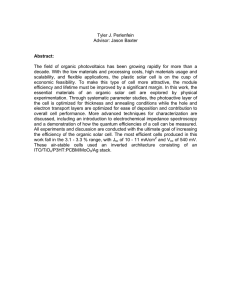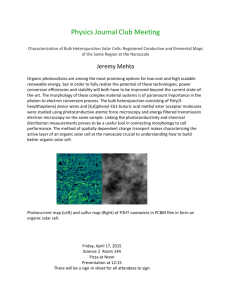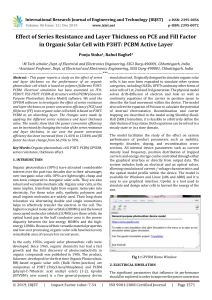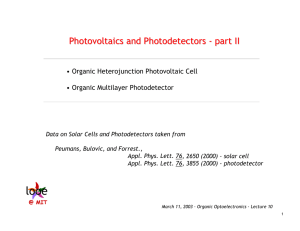Synthesis of Active Layers of Organic Photovoltaics
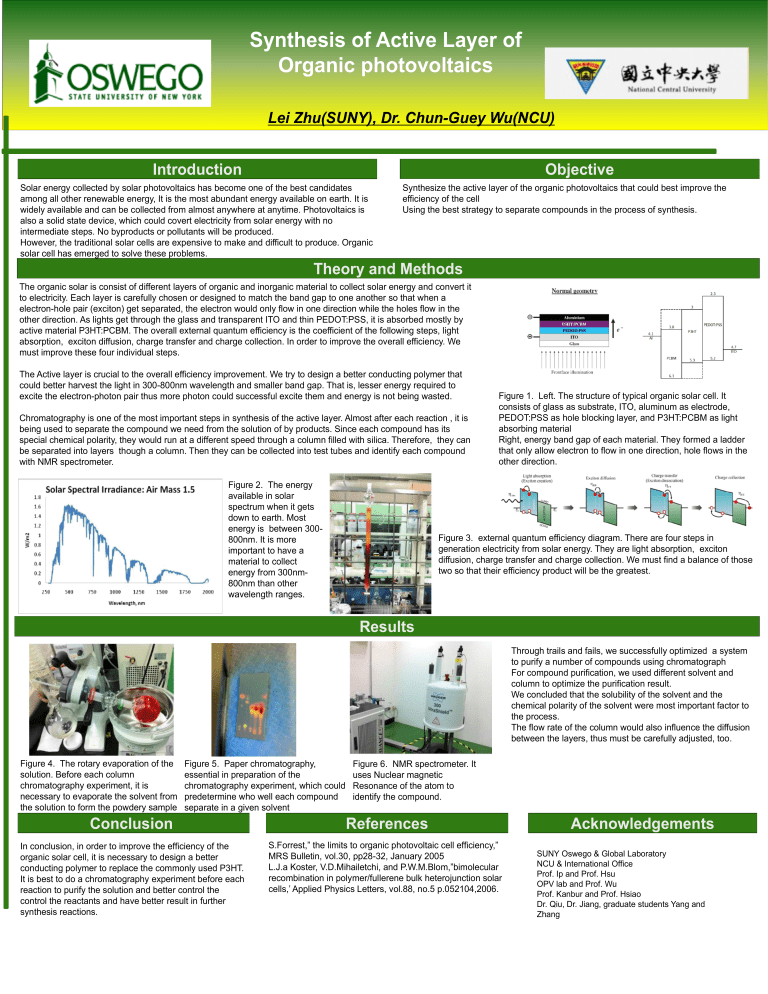
Synthesis of Active Layer of
Organic photovoltaics
Lei Zhu(SUNY), Dr. Chun-Guey Wu(NCU)
Introduction Objective
Solar energy collected by solar photovoltaics has become one of the best candidates among all other renewable energy, It is the most abundant energy available on earth. It is widely available and can be collected from almost anywhere at anytime. Photovoltaics is also a solid state device, which could covert electricity from solar energy with no intermediate steps. No byproducts or pollutants will be produced.
However, the traditional solar cells are expensive to make and difficult to produce. Organic solar cell has emerged to solve these problems.
Synthesize the active layer of the organic photovoltaics that could best improve the efficiency of the cell
Using the best strategy to separate compounds in the process of synthesis.
Theory and Methods
The organic solar is consist of different layers of organic and inorganic material to collect solar energy and convert it to electricity. Each layer is carefully chosen or designed to match the band gap to one another so that when a electron-hole pair (exciton) get separated, the electron would only flow in one direction while the holes flow in the other direction. As lights get through the glass and transparent ITO and thin PEDOT:PSS, it is absorbed mostly by active material P3HT:PCBM. The overall external quantum efficiency is the coefficient of the following steps, light absorption, exciton diffusion, charge transfer and charge collection. In order to improve the overall efficiency. We must improve these four individual steps.
The Active layer is crucial to the overall efficiency improvement. We try to design a better conducting polymer that could better harvest the light in 300-800nm wavelength and smaller band gap. That is, lesser energy required to excite the electron-photon pair thus more photon could successful excite them and energy is not being wasted.
Chromatography is one of the most important steps in synthesis of the active layer. Almost after each reaction , it is being used to separate the compound we need from the solution of by products. Since each compound has its special chemical polarity, they would run at a different speed through a column filled with silica. Therefore, they can be separated into layers though a column. Then they can be collected into test tubes and identify each compound with NMR spectrometer.
Figure 1. Left. The structure of typical organic solar cell. It consists of glass as substrate, ITO, aluminum as electrode,
PEDOT:PSS as hole blocking layer, and P3HT:PCBM as light absorbing material
Right, energy band gap of each material. They formed a ladder that only allow electron to flow in one direction, hole flows in the other direction.
Figure 2. The energy available in solar spectrum when it gets down to earth. Most energy is between 300-
800nm. It is more important to have a material to collect energy from 300nm-
800nm than other wavelength ranges.
Figure 3. external quantum efficiency diagram. There are four steps in generation electricity from solar energy. They are light absorption, exciton diffusion, charge transfer and charge collection. We must find a balance of those two so that their efficiency product will be the greatest.
Results
Through trails and fails, we successfully optimized a system to purify a number of compounds using chromatograph
For compound purification, we used different solvent and column to optimize the purification result.
We concluded that the solubility of the solvent and the chemical polarity of the solvent were most important factor to the process.
The flow rate of the column would also influence the diffusion between the layers, thus must be carefully adjusted, too.
Figure 4. The rotary evaporation of the solution. Before each column chromatography experiment, it is necessary to evaporate the solvent from the solution to form the powdery sample
Figure 5. Paper chromatography, essential in preparation of the chromatography experiment, which could predetermine who well each compound separate in a given solvent
Figure 6. NMR spectrometer. It uses Nuclear magnetic
Resonance of the atom to identify the compound.
Conclusion References
In conclusion, in order to improve the efficiency of the organic solar cell, it is necessary to design a better conducting polymer to replace the commonly used P3HT.
It is best to do a chromatography experiment before each reaction to purify the solution and better control the control the reactants and have better result in further synthesis reactions.
S.Forrest
,” the limits to organic photovoltaic cell efficiency,”
MRS Bulletin, vol.30, pp28-32, January 2005
L.J.a Koster, V.D.Mihailetchi, and P.W.M.Blom
,”bimolecular recombination in polymer/fullerene bulk heterojunction solar cells,’ Applied Physics Letters, vol.88, no.5 p.052104,2006.
